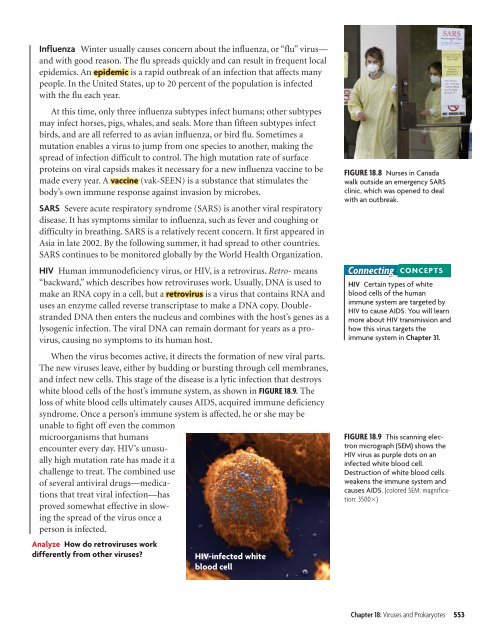18.1 Studying Viruses and Prokaryotes
18.1 Studying Viruses and Prokaryotes
18.1 Studying Viruses and Prokaryotes
You also want an ePaper? Increase the reach of your titles
YUMPU automatically turns print PDFs into web optimized ePapers that Google loves.
Influenza Winter usually causes concern about the influenza, or “flu” virus—<strong>and</strong> with good reason. The flu spreads quickly <strong>and</strong> can result in frequent localepidemics. An epidemic is a rapid outbreak of an infection that affects manypeople. In the United States, up to 20 percent of the population is infectedwith the flu each year.At this time, only three influenza subtypes infect humans; other subtypesmay infect horses, pigs, whales, <strong>and</strong> seals. More than fifteen subtypes infectbirds, <strong>and</strong> are all referred to as avian influenza, or bird flu. Sometimes amutation enables a virus to jump from one species to another, making thespread of infection difficult to control. The high mutation rate of surfaceproteins on viral capsids makes it necessary for a new influenza vaccine to bemade every year. A vaccine (vak-SEEN) is a substance that stimulates thebody’s own immune response against invasion by microbes.SARS Severe acute respiratory syndrome (SARS) is another viral respiratorydisease. It has symptoms similar to influenza, such as fever <strong>and</strong> coughing ordifficulty in breathing. SARS is a relatively recent concern. It first appeared inAsia in late 2002. By the following summer, it had spread to other countries.SARS continues to be monitored globally by the World Health Organization.HIV Human immunodeficiency virus, or HIV, is a retrovirus. Retro- means“backward,” which describes how retroviruses work. Usually, DNA is used tomake an RNA copy in a cell, but a retrovirus is a virus that contains RNA <strong>and</strong>uses an enzyme called reverse transcriptase to make a DNA copy. Doublestr<strong>and</strong>edDNA then enters the nucleus <strong>and</strong> combines with the host’s genes as alysogenic infection. The viral DNA can remain dormant for years as a provirus,causing no symptoms to its human host.When the virus becomes active, it directs the formation of new viral parts.The new viruses leave, either by budding or bursting through cell membranes,<strong>and</strong> infect new cells. This stage of the disease is a lytic infection that destroyswhite blood cells of the host’s immune system, as shown in FIGURE 18.9. Theloss of white blood cells ultimately causes AIDS, acquired immune deficiencysyndrome. Once a person’s immune system is affected, he or she may beunable to fight off even the commonmicroorganisms that humansencounter every day. HIV’s unusuallyhigh mutation rate has made it achallenge to treat. The combined useof several antiviral drugs—medicationsthat treat viral infection—hasproved somewhat effective in slowingthe spread of the virus once aperson is infected.Analyze How do retroviruses workdifferently from other viruses?HIV-infected whiteblood cellFIGURE 18.8 Nurses in Canadawalk outside an emergency SARSclinic, which was opened to dealwith an outbreak.ConnectingCONCEPTSHIV Certain types of whiteblood cells of the humanimmune system are targeted byHIV to cause AIDS. You will learnmore about HIV transmission <strong>and</strong>how this virus targets theimmune system in Chapter 31.FIGURE 18.9 This scanning electronmicrograph (SEM) shows theHIV virus as purple dots on aninfected white blood cell.Destruction of white blood cellsweakens the immune system <strong>and</strong>causes AIDS. (colored SEM; magnification:3500)Chapter 18: <strong>Viruses</strong> <strong>and</strong> <strong>Prokaryotes</strong> 553
















